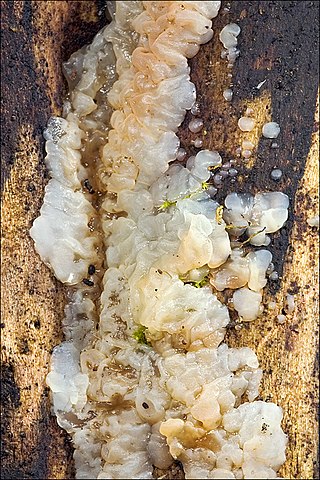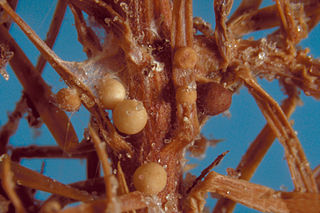
Rhizoctonia solani is a species of fungus in the order Cantharellales. Basidiocarps are thin, effused, and web-like, but the fungus is more typically encountered in its anamorphic state, as hyphae and sclerotia. The name Rhizoctonia solani is currently applied to a complex of related species that await further research. In its wide sense, Rhizoctonia solani is a facultative plant pathogen with a wide host range and worldwide distribution. It causes various plant diseases such as root rot, damping off, and wire stem. It can also form mycorrhizal associations with orchids.
Ceratobasidium ochroleucum is a species of fungus in the family Ceratobasidiaceae. Basidiocarps are effused and web-like and were originally described from Brazil, causing a thread blight of apple and quince trees. The fungus was subsequently reported as a leaf disease on orchard crops in North America, but since descriptions of Ceratobasidium orchroleucum vary considerably and no type specimen exists, its identity remains unclear. Roberts (1999) considered it a "nomen dubium".

Helicobasidium purpureum is a species of fungus in the subdivision Pucciniomycotina. Basidiocarps are corticioid (patch-forming) and are typically violet to purple. Microscopically they have auricularioid basidia. Helicobasidium purpureum is an opportunistic plant pathogen and is one of the causes of violet root rot of crops and other plants. DNA sequencing suggests that it is a complex of more than one species. The species has a conidia-bearing anamorph in the Tuberculina persicina complex that is a parasite of rust fungi.
Helicobasidium longisporum is a species of fungus in the subdivision Pucciniomycotina. Basidiocarps are corticioid (patch-forming) and are typically violet to purple. Microscopically they have auricularioid basidia. Helicobasidium longisporum is an opportunistic plant pathogen and is one of the causes of violet root rot of crops and other plants. DNA sequencing suggests that it is a complex of more than one species.

Ceratobasidium cornigerum is a species of fungus in the order Cantharellales. Basidiocarps are thin, spread on the substrate out like a film (effused) and web-like. An anamorphic state is frequently obtained when isolates are cultured. Ceratobasidium cornigerum is saprotrophic, but is also a facultative plant pathogen, causing a number of economically important crop diseases, and an orchid endomycorrhizal associate. The species is genetically diverse and is sometimes treated as a complex of closely related taxa. DNA research shows the species actually belongs within the genus Rhizoctonia.
Waitea circinata is a species of fungus in the family Corticiaceae. Basidiocarps are corticioid, thin, effused, and web-like, but the fungus is more frequently encountered in its similar but sterile anamorphic state. Waitea circinata is best known as a plant pathogen, causing commercially significant damage to amenity turf grass.
Corticium invisum is a species of fungus in the class Agaricomycetes. It is a corticioid fungus and a plant pathogen, the causal agent of black rot of tea, and was originally described from Sri Lanka. Corticium invisum has never been redescribed or reviewed and is unlikely to be a species of Corticium in the modern sense. Roberts (1999) referred Petch's original specimens to Ceratobasidium cornigerum.
Helicobasidium mompa is a species of fungus in the subdivision Pucciniomycotina. Basidiocarps are corticioid (patch-forming) and are typically violet to purple. Microscopically they have auricularioid basidia. Helicobasidium mompa is an opportunistic plant pathogen and is one of the causes of violet root rot of crops and other plants. DNA sequencing suggests that it is a distinct, eastern Asian species.

Oxyporus is a genus of polypore fungi in the family Schizoporaceae. An individual family Oxyporaceae was described for the genus. A number of species in this genus are plant pathogens, causing a white rot. The genus is widely distributed.

Phanerochaete is a genus of crust fungi in the family Phanerochaetaceae.

Peniophora is a genus of fungi which are plant pathogens. Members of the genus belong to the class Agaricomycetes, order Russulales, and family Peniophoraceae. The genus is widespread, and contains 62 species. The species of Peniophora are resupinate, or crust-like, and are described as corticioid. A number of its members are parasitised by other fungi. For example, Tremella mesenterica is a parasite to several species of Peniophora.

The corticioid fungi are a group of fungi in the Basidiomycota typically having effused, smooth basidiocarps that are formed on the undersides of dead tree trunks or branches. They are sometimes colloquially called crust fungi or patch fungi. Originally such fungi were referred to the genus Corticium and subsequently to the family Corticiaceae, but it is now known that all corticioid species are not necessarily closely related. The fact that they look similar is an example of convergent evolution. Since they are often studied as a group, it is convenient to retain the informal (non-taxonomic) name of "corticioid fungi" and this term is frequently used in research papers and other texts.

Ceratobasidium is a genus of fungi in the order Cantharellales. Basidiocarps are effused and the genus is sometimes grouped among the corticioid fungi, though species also retain features of the heterobasidiomycetes. Anamorphic forms were formerly referred to the genus Ceratorhiza, but this is now considered a synonym of Rhizoctonia. Ceratobasidium species, excluding the type, are also now considered synonymous with Rhizoctonia and some species have been transferred to the latter genus. Species are saprotrophic, but several are also facultative plant pathogens, causing a number of commercially important crop diseases. Some are also endomycorrhizal associates of orchids.

Rhizoctonia is a genus of fungi in the order Cantharellales. Species form thin, effused, corticioid basidiocarps, but are most frequently found in their sterile, anamorphic state. Rhizoctonia species are saprotrophic, but some are also facultative plant pathogens, causing commercially important crop diseases. Some are also endomycorrhizal associates of orchids. The genus name was formerly used to accommodate many superficially similar, but unrelated fungi.
Waitea is a genus of fungi in the family Corticiaceae. Basidiocarps are corticioid, thin, effused, and web-like, but species are more frequently encountered in their similar but sterile anamorphic states. Several species are plant pathogens, causing commercially significant damage to cereal crops and amenity turf grass.

The Ceratobasidiaceae are a family of fungi in the order Cantharellales. All species within the family have basidiocarps that are thin and effused. They have sometimes been included within the corticioid fungi or alternatively within the "heterobasidiomycetes". Species are saprotrophic, but some are also facultative plant pathogens or are associated with orchid mycorrhiza. Genera of economic importance include Ceratobasidium and Rhizoctonia, both of which contain plant pathogenic species causing diseases of commercial crops and turf grass.

Exidia thuretiana is a jelly fungus in the family Auriculariaceae. The fruit bodies are white and gelatinous with brain-like folds. It is a common, wood-rotting species in Europe, typically growing on dead attached or fallen branches of broadleaf trees, especially beech.

Botryobasidium is a genus of corticioid fungi belonging to the order Cantharellales. Basidiocarps are ephemeral and typically form thin, web-like, white to cream, effused patches on the underside of fallen branches, logs, and leaf litter. Several species form anamorphs producing chlamydospores. All species are wood- or litter-rotting saprotrophs and the genus has a worldwide distribution.
Oliveonia is a genus of fungi in the order Auriculariales. Species form thin, effused, corticioid basidiocarps with microscopically prominent cystidia and aseptate basidia producing basidiospores that give rise to secondary spores. All species are believed to be saprotrophic, most growing on dead wood. The genus was originally published by American mycologist L.S. Olive in 1957 as Heteromyces, but this is an illegitimate later homonym of the lichen genus Heteromyces Müll.Arg. (1889). The genus was renamed Oliveonia by Dutch mycologist M.A. Donk in 1958.

Agroathelia rolfsii is a corticioid fungus in the order Amylocorticiales. It is a facultative plant pathogen and is the causal agent of "southern blight" disease in crops.











